Welcome New Members of the MLC October 2024
Introducing the latest new members to the Manufacturing Leadership Council


Johan Carstens
Head of Smart and Sustainable Manufacturing
Fujitsu Americas

https://www.fujitsu.com/global/solutions/industry/manufacturing/
![]()
https://www.linkedin.com/in/johan-hermanus-carstens-85776413b/

John Marth
Senior Industry Advisor
Workday

www.workday.com
![]()
https://www.linkedin.com/in/john-marth-bb155548/

Jay Merenda
Strategy Lead, Digital and Data Analytics
Chemours

https://www.chemours.com/en
![]()
https://www.linkedin.com/in/jaymerenda/

Scott Nelson
VP Global Operational Excellence
Dover Corporation

https://www.dovercorporation.com/
![]()
https://www.linkedin.com/in/scott-nelson-56ab516/

Maurice O’Brien
Director – Strategic Marketing, Industrial Automation
Analog Devices
https://www.analog.com/en/index.html
![]()
https://www.linkedin.com/in/maurice-o-brien-46130218/

Jim O’Connor
CIO
Graham Packaging
![]()
https://www.grahampackaging.com
![]()
https://www.linkedin.com/in/jim-o-connor-11022b10/

Matt Prange
Senior Vice President, Global Supply Chain
Milwaukee Tool

https://www.milwaukeetool.com/
![]()
https://www.linkedin.com/in/matthewprange/

Andy Reich
Senior Director of Digital Transformation
Worthington Steel
![]()
www.worthingtonsteel.com
![]()
https://www.linkedin.com/in/andy-reich-673bb7126/

Aaron Schoonbaert
COO
Price Industries
![]()
https://www.priceindustries.com/
![]()
https://www.linkedin.com/in/aaron-schoonbaert-7438326/

Keith Sinram
Senior Vice President
Crown Equipment Corporation
![]()
https://www.crown.com/en-us.html
![]()
https://www.linkedin.com/in/sinram/
Learn how you can join the MLC here:
Join the MLC
Survey: Leadership Preparedness Improves, but Gaps Remain

MLC’s Digital Leadership survey finds that while more organizations have restructured to build an M4.0 advantage, organizational readiness continues to lag.
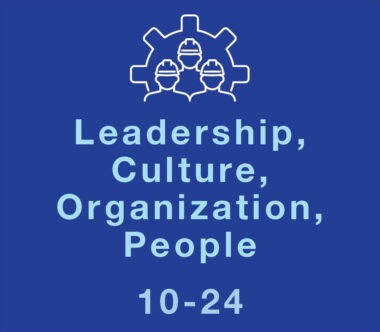
KEY TAKEAWAYS:
● Digital manufacturing leaders need to build traditional leadership qualities with new skills such as fostering a data-driven culture and guiding the workforce through change.
● Despite progress in creating digital strategies, many manufacturers lack formal training programs for upskilling their workforce, and many feel that leadership is unprepared for the future.
● Effective digital leadership is characterized by collaboration both internally and externally, while successfully building and navigating digital ecosystems.
While there are many tried-and-true qualities of good leadership that stand the test of time – innovation, integrity, confidence – the additional skills required of digital manufacturing leaders have evolved just like the technologies giving rise to Manufacturing 4.0.
Today’s operational leaders need an eye toward building data-driven business cultures and decision-making; the ability to collaborate with teams both inside and outside of their organization; the skill to help their teams adapt in times of change; and much more. There are also more traditional leadership skills that look different than they used to; for example, continuous improvement in a digital ecosystem, and a focus on upskilling the workforce on new technologies and methodologies.
The Manufacturing Leadership Council’s 2024 Digital Leadership survey reveals that while organizational structures are adjusting to the needs for digital manufacturing, there are still gaps to address for full business readiness.
Section 1: The Organizational Motto: Be (Mostly) Prepared
Anyone who has been involved with a scouting organization in their youth is likely to recall the famous motto: “Be Prepared.” It seems that more digital manufacturing leaders, as well as their organizations, are (mostly) coming around to this motto as good advice. But at the same time, more than half of manufacturers are not offering any formal digital training to educate or upskill the workforce and leadership (Chart 3), and 88% of respondents feel that their company’s future has at least some future vulnerability due to its current digital transformation preparedness (Chart 5).
Meanwhile, more organizations have created a change management strategy around digital transformation (Chart 1) and/or have restructured or redesigned themselves to better manage digitalization (Chart 2). But understanding the digital roles and skills that will be required by the future manufacturing enterprise is only somewhat understood by most (Chart 4.)
1. Most Have a Change Management Strategy in Place
Q: Has your leadership team created an organizational change management strategy to help support its digital strategy? (Select one)

2. Organizations are Restructuring Around Digital
Q: As part of its digital transformation work, has your company undertaken organizational redesign to better manage the impact of digitalization? (Select one)

3. Still, Formal Training Programs are Lacking
Q: Does your company have a formal training plan to educate workers and leadership around the requirements of digital transformation? (Select one)

4. Future Roles and Skills Needs Only Somewhat Understood
Q: How well prepared do you think your company is in understanding the new digital roles and skills that you will need in the next few years? (Select one)

5. Current Levels of Digital Readiness Create Vulnerabilities
Q: How vulnerable will your company’s future success be as a direct result of your company’s current level of digital transformation preparedness? (Select one)

Section 2: Digital Leadership is a Team Sport
As technology enables individuals and teams to become more connected both internally and to external customers and partners, the ability to collaborate is key. So too is it key among leadership teams, as leaders need to understand the impact that digital investment and deployment will have on different areas of the enterprise. The top response for “who is in charge” for digital transformation efforts was that it is a collaborative effort (Chart 6). It’s likely a positive sign that most respondents — 85% — rates their leadership teams as either “highly” or “somewhat” collaborative (Chart 8).
Perhaps unsurprisingly, executive management teams most frequently want to know the value of digital investments – the business case for them, and what specific use cases will bring the most bang for the buck (Chart 7). But only 23% rate their executives as “very prepared” to lead and manage digital transformation (Chart 9).
6. Leadership is Most Often Collaborative
Q: Who is leading the charge around the digital transformation efforts in your organization?
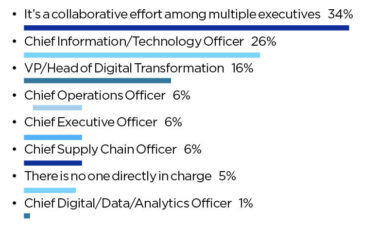
7. Executives Most Often Want to Know Business Value
Q: What is the most important thing your company’s executive management team wants to know about digital transformation? (Select top 3)
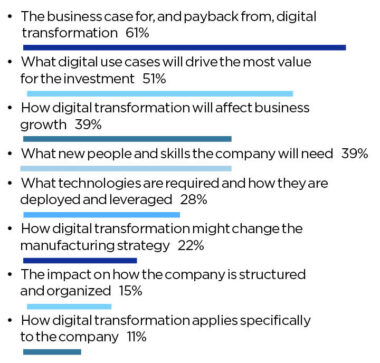
8. Cross-Organizational Leaders Collaborate on Strategy
Q: How collaborative is your leadership team across multiple areas of the organization in the development and assessment of its digital strategy? (Select one)
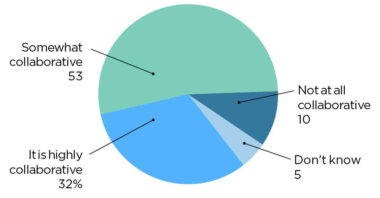
9. Executive Management is Only Somewhat Prepared for Digital Transformation
Q: How prepared do you think your company’s executive management team is to lead and manage digital transformation? (Select one)

Section 3: The Meaning of Leadership in the M4.0 Era
When asked which statements best describe an M4.0 leader, ecosystem-based external and internal collaboration once again came up as a key theme, along with understanding technology integration and creating an information-driven culture (Chart 10). Additionally, most respondents — 74% — believe that digital operations require a substantially different approach and skill set for leaders (Chart 11).
As for the skills and abilities that respondents believe are most important, the highest degree of importance was placed on using digital technology to reduce costs and improve efficiency, followed by the willingness and ability to rethink traditional business to successfully embrace a digital model (Chart 13).
In business, the definition of a good leader has been and will continue to be one who inspires and brings out the best in others, in addition to making smart business decisions to bring about success. Technology is a burgeoning part of the play, but those individuals who dare to act as visionaries in creating winning strategies will continue to be the ones who find success. N
10. Leaders Must Navigate Digital Ecosystems and Understand Digital Integration
Q: Which statements best describe what leadership means in the digital era? (Select top 3)
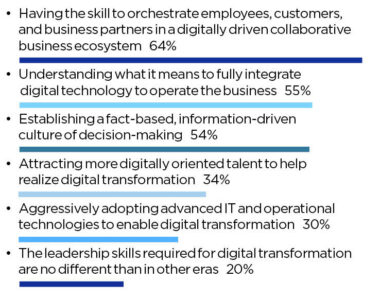
11. Digital-Era Leadership Requires a Substantially Different Approach
Q: Do you agree or disagree with this statement: The emergence of digitally driven operations and business models will require a substantially different approach and set of skills on the part of manufacturing company leadership. (Select one)

12. Digital Acumen, Building a Data-Driven Culture Most Important for Leaders
Q: Which leadership approaches do you feel are most important in the digital era? (Select top 3)
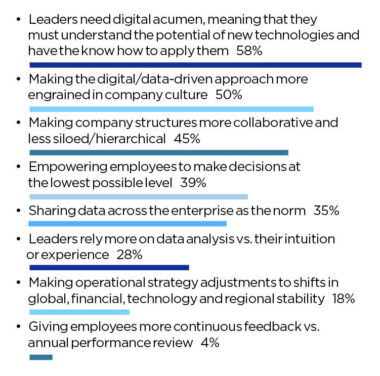
13. Most Important Skills: Reimagined Business Models; Successful Technology Deployment
Q: Looking ahead, what degree of importance would you assign to the following digital leadership skills and abilities? (Rate each on scale of Low/Medium/High)
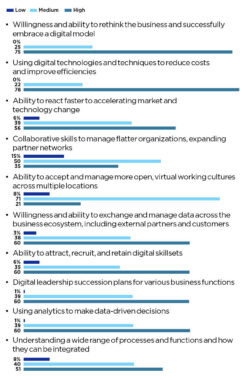
About the author:

Penelope Brown Senior Content Director, Manufacturing Leadership Council
Meet the Manufacturing Leader of the Year

If you’re looking for insights on digital transformation, cultural change and what’s ahead for manufacturing, it pays to consult an industry leader. Dan Dwight, president and CEO of Cooley Group, fits the bill.
Dwight was named the 2024 Manufacturing Leader of the Year in the Manufacturing Leadership Awards, presented by the Manufacturing Leadership Council, the digital transformation division of the NAM. Additionally, Cooley Group won the Small/Medium Enterprise Manufacturer of the Year and the Manufacturing in 2030 Award.
Recently, Dwight sat down for an Executive Dialogue interview with the Manufacturing Leadership Journal to share his secrets to success. Below are excerpts from the interview.
What leaders need: When asked what qualities manufacturing leaders need in the digital era, Dwight says that they must be willing to undergo big changes, but must also keep their teams in the loop.
- “Successful leadership in the digital era demands, among other things, a higher level of transparency,” he explained. “Your team needs to see the road map in front of them because successful and sweeping transformations are extremely time consuming with a lot of jagged edges that the leadership team needs to address.”
How cultures should change: As for the wider cultural changes that will help a company through its digital transformation, resiliency and adaptability are crucial, Dwight said.
- “Cooley’s digital transformation began with a cultural transformation built around becoming more agile and adaptable,” he noted. “Every decision we make places long-term resiliency and cross-functional collaboration as our operational North Star.”
- “Cooley decentralized our decision-making structures, eliminating hierarchal instruction and empowering team members to communicate transparently and more frequently,” he added.
Small manufacturers’ advantage: When asked whether small and medium-sized manufacturers are at a disadvantage in the era of digital transformation, Dwight says that Cooley has turned its small size into an asset.
- “Our longevity is built on using our size to our advantage. We are more resilient, more agile, more adaptable than our competitors who are often [much larger] because we constantly invest in pro-growth strategies regardless of the economic environment,” he explained.
- “Our investments in innovation generate consistent new product revenue of over 20%, and our investments in Manufacturing 4.0 digitization generate consistent, robust productivity dividends,” Dwight added.
What’s next? Cooley Group is looking ahead to further transformations, including in supply chain management, Dwight said.
- “Our business architecture and change management team leaders are working within their respective teams across the organization to build into our processes a more outward-looking focus,” he said.
- “For example, our M4.0 implementation leader has added supply chain resiliency to her leadership responsibilities. Her team seeks to build out Cooley’s end-to-end business resilience.”
MLC in action: Dwight says that Cooley Group has always been able to count on the MLC to find the insights that it needs for digital transformation and its Manufacturing 4.0 journey. As he put it recently, “When challenges do arise, the MLC can help us think through what the future might look like.”
Watch a full video of this interview for more insights.
Seventy Percent of Manufacturers Still Enter Data Manually

Manufacturers are deluged by data. As companies adopt more advanced technologies, they are increasingly overwhelmed by the quantities of raw data that must be collected, analyzed and put to use.
Indeed, a new survey from the Manufacturing Leadership Council—the NAM’s digital transformation arm—reveals that 70% of manufacturers still collect data manually. Here are some highlights from the survey, which reveals where manufacturers need to improve, and how they’re planning to do it.
Exponential data growth: While the survey’s respondents report an explosion of new data, they also expect to keep on top of it over the next few years.
- Forty-four percent of manufacturing leaders have seen at least a doubling of the amount of data they collect in their organization today compared to two years ago.
- While many manufacturers still lack standardized data due to operating a mix of older equipment and systems along with newer technologies, more than half expect that their data will be in a standardized format by 2030.
Analytical improvements: How are manufacturers planning to use all this new data?
- Nearly 60% of respondents say they are focused on understanding their operations with an eye toward optimizing them in the future.
- While 30% of manufacturers say they are using manufacturing data to predict operational performance, another 60% say that predictivity will be a primary objective by 2030.
Better decisions: Manufacturers use data to make better, more proactive decisions, according to the survey. Today, these decisions are made at a relatively high level.
- Seventy-seven percent of respondents said that the responsibility to employ data in decision-making falls to plant leaders and managers.
- Only 33% said that factory floor employees held that responsibility—a percentage that might grow as manufacturers seek to empower frontline employees with greater decision-making ability.
Looking ahead: As artificial intelligence and other emerging digital technologies become more established, they will likely reshape many if not all aspects of manufacturing operations.
- Thanks to advanced sensors and robust data networks connecting equipment and machinery, manufacturers will collect copious data in real time and act on it almost as swiftly.
Read more: To get a deeper look at the current state of data mastery in manufacturing, download the full survey, Data Mastery: A Key to Industrial Competitiveness.
Seventy Percent of Manufacturers Still Enter Data Manually

Manufacturers are deluged by data. As companies adopt more advanced technologies, they are increasingly overwhelmed by the quantities of raw data that must be collected, analyzed and put to use.
Indeed, a new survey from the Manufacturing Leadership Council—the NAM’s digital transformation arm—reveals that 70% of manufacturers still collect data manually. Here are some highlights from the survey, which reveals where manufacturers need to improve, and how they’re planning to do it.
Exponential data growth: While the survey’s respondents report an explosion of new data, they also expect to keep on top of it over the next few years.
- Forty-four percent of manufacturing leaders have seen at least a doubling of the amount of data they collect in their organization today compared to two years ago.
- While many manufacturers still lack standardized data due to operating a mix of older equipment and systems along with newer technologies, more than half expect that their data will be in a standardized format by 2030.
Analytical improvements: How are manufacturers planning to use all this new data?
- Nearly 60% of respondents say they are focused on understanding their operations with an eye toward optimizing them in the future.
- While 30% of manufacturers say they are using manufacturing data to predict operational performance, another 60% say that predictivity will be a primary objective by 2030.
Better decisions: Manufacturers use data to make better, more proactive decisions, according to the survey. Today, these decisions are made at a relatively high level.
- Seventy-seven percent of respondents said that the responsibility to employ data in decision-making falls to plant leaders and managers.
- Only 33% said that factory floor employees held that responsibility—a percentage that might grow as manufacturers seek to empower frontline employees with greater decision-making ability.
Looking ahead: As artificial intelligence and other emerging digital technologies become more established, they will likely reshape many if not all aspects of manufacturing operations.
- Thanks to advanced sensors and robust data networks connecting equipment and machinery, manufacturers will collect copious data in real time and act on it almost as swiftly.
Read more: To get a deeper look at the current state of data mastery in manufacturing, download the full survey, Data Mastery: A Key to Industrial Competitiveness.
Seventy Percent of Manufacturers Still Enter Data Manually

Manufacturers are deluged by data. As companies adopt more advanced technologies, they are increasingly overwhelmed by the quantities of raw data that must be collected, analyzed and put to use.
Indeed, a new survey from the Manufacturing Leadership Council—the NAM’s digital transformation arm—reveals that 70% of manufacturers still collect data manually. Here are some highlights from the survey, which reveals where manufacturers need to improve, and how they’re planning to do it.
Exponential data growth: While the survey’s respondents report an explosion of new data, they also expect to keep on top of it over the next few years.
- Forty-four percent of manufacturing leaders have seen at least a doubling of the amount of data they collect in their organization today compared to two years ago.
- While many manufacturers still lack standardized data due to operating a mix of older equipment and systems along with newer technologies, more than half expect that their data will be in a standardized format by 2030.
Analytical improvements: How are manufacturers planning to use all this new data?
- Nearly 60% of respondents say they are focused on understanding their operations with an eye toward optimizing them in the future.
- While 30% of manufacturers say they are using manufacturing data to predict operational performance, another 60% say that predictivity will be a primary objective by 2030.
Better decisions: Manufacturers use data to make better, more proactive decisions, according to the survey. Today, these decisions are made at a relatively high level.
- Seventy-seven percent of respondents said that the responsibility to employ data in decision-making falls to plant leaders and managers.
- Only 33% said that factory floor employees held that responsibility—a percentage that might grow as manufacturers seek to empower frontline employees with greater decision-making ability.
Looking ahead: As artificial intelligence and other emerging digital technologies become more established, they will likely reshape many if not all aspects of manufacturing operations.
- Thanks to advanced sensors and robust data networks connecting equipment and machinery, manufacturers will collect copious data in real time and act on it almost as swiftly.
Read more: To get a deeper look at the current state of data mastery in manufacturing, download the full survey, Data Mastery: A Key to Industrial Competitiveness.
Manufacturing Leadership Council Elects Two New Industry Leaders to Board of Governors
Washington, D.C. – The Manufacturing Leadership Council, the digital transformation division of the National Association of Manufacturers, has announced the election of Dow Global Operations Director for Operational Excellence and Leveraged Services Tim O’Neal and PIC Trailers President Bryan Van Itallie to the MLC’s Board of Governors. The MLC is the nation’s leading networking and executive leadership organization dedicated to digital transformation in manufacturing by focusing on the technological, organizational and leadership dimensions of change.

O’Neal is responsible for improving the performance of people and processes through continuous learning, professional development, effective teams and cost-effective implementations. He also leads strategic initiatives for operations, including digital strategy. He has been with Dow for 23 years and has lead initiatives in environmental, health, safety and sustainability; supply chain; R&D; logistics; and operations IT technology.
Van Itallie leads all aspects of PIC’s business and has led development of a new, metrics-driven vision, mission, core values and strategic plan for the company. He has increased the company’s monthly revenue; developed and launched new intermodal chassis; spearheaded a company culture transformation; and improved talent development and management to better align employee skills.

“The addition of Tim and Bryan brings robust skill sets and deep experience to the MLC board, and we welcome their fresh perspectives,” said Cooley Group President and CEO and MLC Board of Governors Chairman Dan Dwight. “Collaborations like these are essential not only for strengthening the MLC, but also for improving the industry’s future.”
“The MLC is fortunate to have a dedicated group of industry experts to guide and shape our mission as manufacturing’s digital landscape continues to evolve,” said MLC Founder, Executive Director and Vice President David R. Brousell. “These new additions further enhance the depth and breadth of knowledge on our board and solidify our position as an organization that is at the forefront of digital manufacturing.”
As an advisory body, the MLC Board of Governors provides guidance to the MLC on its annual Critical Issues agenda, research studies and programs and services for the MLC membership.
-About the MLC-
Founded in 2008 and now a division of the National Association of Manufacturers, the Manufacturing Leadership Council’s mission is to help manufacturing companies transition to the digital model of manufacturing by focusing on the technological, organizational and leadership dimensions of change. With more than 2,500 senior-level members from many of the world’s leading manufacturing companies, the MLC focuses on the intersection of advanced digital technologies and the business, identifying growth and improvement opportunities in the operation, organization and leadership of manufacturing enterprises as they pursue their journeys to Manufacturing 4.0.
Exploring Automation and Culture at Amazon
From garage to global giant: how innovation, data and machine learning drive Amazon’s BFI4 Fulfillment Center

Nearly 30 years ago, in a Seattle-area garage, Jeff Bezos and the few employees of his upstart online retailer, Amazon, knelt on the floor to pack customer orders into boxes. One evening, Bezos suggested ordering kneepads to make the work more comfortable. One of his workers respectfully disagreed and suggested they order packing tables instead – an option that proved to be better for worker satisfaction and throughput. This early example of centering durable needs, rather than immediate or short-term needs, exemplifies the culture of innovation that now permeates Amazon.
During MLC’s sold-out tour of Amazon’s BFI4 Fulfillment Center cohosted by Amazon Business and Amazon Web Services, participants got a behind-the-scenes look at how the company sorts and packages thousands of items per day for delivery to customers. The tour also provided insights into Amazon’s approach to data, supply chain and procurement, offering a deep dive into the progression of the company’s culture from its early days.
During his presentation on the culture of innovation, Clint Schneider, Amazon Web Services’ Digital Innovation Lead for Smart Factories, shared how culture, mechanisms, architecture and organization lead to better innovation. Schneider explained how Amazon’s decision-making process uses the concept of “one-way” or “two-way” doors to make high-quality, high-velocity decisions. A one-way door represents a significant decision like should Amazon build a new facility, while a two-way door represents something less critical, like changing the buy button’s color.
Using the one-way versus two-way door analysis helps the company innovate faster with a bias for action. If it is a two-way door, they know they do not have to deliberate as long. Instead, they can run the experiment and move back through the door to adjust or revert if the decision does not produce the intended results and ROI.
Automation and Innovation at Amazon’s BFI4 Fulfillment Center
“This is what we manufacture,” Julius Yu, General Manager of Amazon’s BFI4 Fulfillment Center shares as he holds one of the thousands of packed boxes filled with a customer’s order that move by the MLC tour group as they walk through the facility. “Everything we manufacture here is unique.”
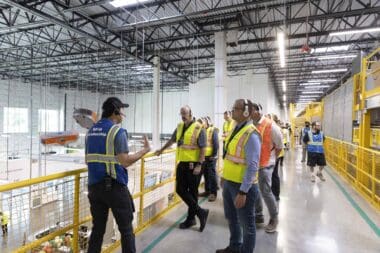
BFI4 handles millions of units per week, each with a distinct mix of “parts” that are sorted, picked, packed, inspected, sealed, labeled and distributed for delivery. BFI4 is Amazon’s eighth iteration of an Amazon robotics fulfillment center. In total, BFI4 has thousands of mobile robots storing and transporting products between stations where they are manually sorted for storage then picked and packed for delivery.
At the sort station, employees put items into random bins for storage until a customer orders the product. Using a vision system, a camera takes a picture of where the item has been randomly placed so that it can be retrieved and transported via AMR to the pick station when ordered.
After the product is ordered and delivered to the pick station, a control panel tells employees where it is located on the rack so they can move it into a bin to be packed into a customer’s box. Computer vision verifies the number of items in each bin, taking pictures to ensure accuracy.
Harnessing Data to Improve Efficiency
Data, data management, and data contextualization are integral to operations at BFI4. The company generates terabytes of data to ensure end-to-end transparency. Machine learning helps determine which fulfillment center or distribution center across the country should house each product, using historical ordering patterns with about 60% accuracy. These determinations help to improve delivery speeds, and have resulted in more efficient delivery routes. While machine learning hasn’t helped Amazon achieve 100% accuracy yet, Yu is optimistic that advancements in technology, computing power and artificial intelligence will improve precision.
One notable innovation using data is a custom box maker. For orders that include a single item, Amazon’s machine will custom cut cardboard to create a shipping box. The custom box maker relies on product data to determine the correct size of the box so that it can fit snug around the product. The downstream benefits are significant. The company can fit more boxes into trucks, for example, which is a positive for both sustainability and throughput.
An Immersive Amazon Experience
Participants enjoyed a networking reception the evening prior to the tour featuring entertainment by Washington-based 2019 American Idol contestant Kazmyn, food options from local vendors, and a trip to Amazon’s iconic Banana Stand – all hosted in Amazon’s Spheres, an innovative coworking space. The reception gave participants an opportunity to network with fellow tour participants and Amazon ambassadors while immersed in a unique Amazon workspace ecosystem.

Following the tour, attendees engaged with a panel of Amazon experts including Julius Yu, Brian Steward (Director of Worldwide Amazon Business Operations), and Mobeen Khan (Director, Global Business Development and Partnerships), facilitated by MLC’s Senior Content Director, Penelope Brown. The panelists addressed questions about the BFI4 facility, data, culture, safety and Amazon’s processes.
The Amazon tour experience concluded with a session titled “Manufacturing at Amazon: The Future, Faster, Together,” covering three pillars for manufacturing’s future: data as a foundation, AWS supply chain, and strategic procurement.
For participants, the tour proved to be a fascinating opportunity to see how far Amazon has come since those earliest days when employees packed customer orders in a garage and where the company’s culture of innovation may lead it in the future.
Building a Generative AI-Powered Digital Twin
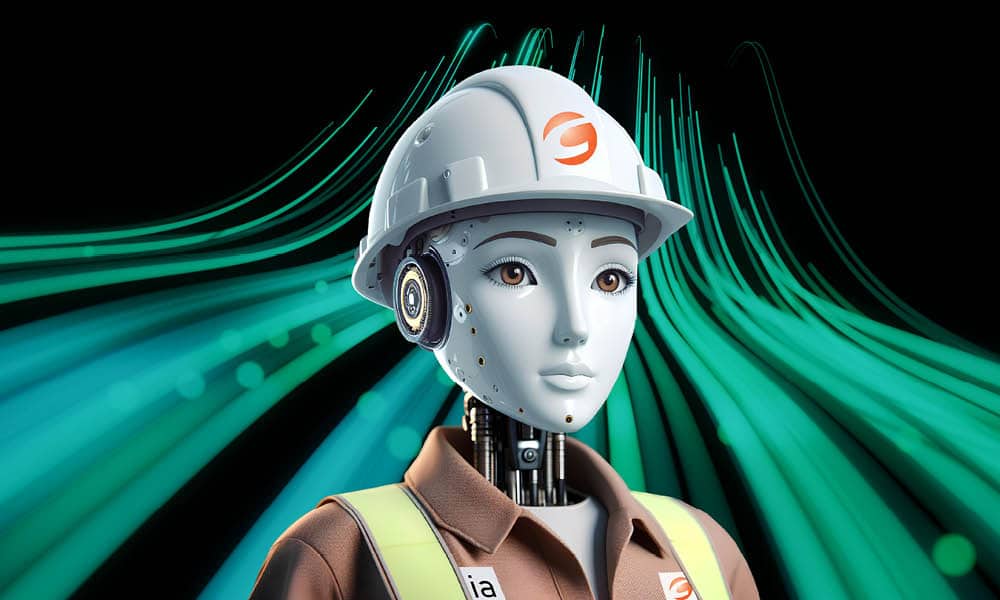
As part of its accelerated digitalization journey, Celanese has developed a generative AI chatbot to serve as a user-friendly interface to its Digital Twin.

TAKEAWAYS:
● Digital transformation requires getting the data into the hands of experts who will build, deploy, and scale hundreds of use cases.
● A generative AI chatbot can function as an everyday manufacturing assistant to support those use cases.
● Celanese’s digital platform and standardized knowledge graph, supported by its AI chatbot Celia, is already reaping returns in multiple areas, from troubleshooting and production performance to improved decision making.
Celanese is on a journey to transform its manufacturing processes into autonomous, integrated, and optimized digital plants — and at the heart of it is a user-friendly, generative AI-powered chatbot named Celia. Think of Celia as a copilot that can integrate into workflows and provide real-time suggestions, explanations, and feedback during industrial processes to users in easily understandable, native language. Celia retrieves that information it’s providing through its connection to the unified digital platform and its comprehensive knowledge graph.
Celia was put in place to provide a synergy between users and generative AI models that will enhance the quality and accuracy of results and foster faster, more informed decision making. Celanese believes its digital transformation is an ongoing journey to put data into the hands of experts who will build, deploy, and scale hundreds of use cases.
With the digital platform that Celanese is using and its ability to scale, the Celia copilot is designed to function as an everyday manufacturing assistant to the company’s manufacturing operations personnel by supporting use cases including incident management, real-time process plant optimization, automatic EIP isolations, connected worker, asset performance management, incident management, and real-time process optimization.
While the project is a work in progress, Celanese, a global manufacturer of special materials and chemical products used in most major industries and consumer applications, has realized real value … and it’s just getting started.
Project Evolution
Celia is the latest development in the company’s accelerated digitalization journey. The journey started with replicating each actual physical asset at its Clear Lake, Texas, manufacturing site in a pilot in May 2022. The digital twin foundation scale was then implemented at 30 sites in 2023. While this is a technological development, it has always been centered around designing solutions for real people that go beyond being just user-friendly interfaces to constituting repeatable processes that leverage design principles and human insights to address future opportunities.
The digital twin implementation alone was a leap forward in troubleshooting, collaboration, historical data tracking and trending, and improved compliance, among other benefits.
“Think of Celia as a copilot that can seamlessly integrate into workflows and provide real-time suggestions, explanations, and feedback.”
Keeping with that human-centric focus, Celia was launched in the fall of 2023 to drive value, insights, and further enhancements to production, processes, and people engagement. Celia’s detailed industrial knowledge graph spans more than 30 manufacturing sites and integrates operational, engineering, and process data to provide a complete digital representation it can use to understand and optimize operations.
With the rollout of Celia across many of its manufacturing sites, Celanese has already successfully improved visibility, collaboration, provided instantaneous insights on troubleshooting and production performance, provided results of forecasts/predictions alongside AI/ML, improved decision making, and reduced time spent on data discovery and analysis.
Transforming Workflows, Reducing Downtimes
In less than a year since launch, Celia has equipped employees with contextualized information at their fingertips. For example, the AI chatbot has leveraged the knowledge graph to transform workflows for operators by enabling tasks such as operator rounds being executed more efficiently. Celia has also provided troubleshooting insights that connect maintenance notifications and work orders, maintenance instructions, operator manuals and standard operating procedures that help advise operators and maintenance staff with recommended actions to take.
Celia has also eliminated energy accounting and billing errors by generating real-time insights into internal operational factors, as well as integrating to external energy prices. Compliance and audits have benefitted from Celia comparing site policies and procedures to corporate policy procedures and generating gap closure actions in just minutes (compared to what previously took days), rather than the time and effort it took to manually do these comparisons to support gap assessments and develop action plans.
“Celia has already provided employees with contextualized information at their fingertips.”
Catalyst inventory management is also reaping benefits with Celia. The AI chatbot now can digitally track, estimate, and inspect the company’s precious metal inventory across manufacturing sites, including incoming and outgoing shipments between the warehouse, vendors, and operating units. Digitally accounting for the inventory enables Celanese to continuously update its estimates of price, amounts and quality — and helps to reduce total amount of inventory.
Lastly, troubleshooting is more efficient with Celia. Celanese has successfully used it to optimize performance at one of its largest facilities by providing anomalies in real-time price forecasting and insights that enabled the company to make decisions on managing downtime that resulted in cost avoidance.
Innovating for the Future
Many tactical approaches focus too much on the discrete business solutions at hand instead of strategically architecting to solve current challenges, while also unlocking subsequent business solutions. Celanese wanted to shift to a platform architecture that would enable an open solution development acceleration model, allowing the company to leverage AI/ML and generative AI at scale to drive value.
The opportunities for future uses of generative AI to create repeatable, optimized, and autonomous digital solutions continue to be explored by Celanese for its chemical and specialty materials manufacturing facilities globally. M
COMPANY FACT FILE
Name: Celanese Corporation
Sector: Specialty materials and chemical products
Global HQ location: Irving, Texas
Revenues: 2023 net sales of $10.9 billion
Employees: 12,400
Web url: http://www.celanese.com
About the authors:

Sue Pelletier is a contributing editor with the Manufacturing Leadership Journal.
Dialogue: Change is the Only Constant

Cooley Group President and CEO, Dan Dwight – our 2024 Manufacturing Leader of the Year – explores digital transformation, cultural change and what’s next.
Jeff Puma: Hello everybody and welcome to our third edition of the Manufacturing Leadership Journal Executive Dialogue series. We’re excited today to be joined by Dan Dwight, Cooley Group president and CEO, and this is an exciting time to have Dan with us. For those who were at the Manufacturing Leadership Awards this year you know that Cooley Group was a finalist in three categories: AI and Machine Learning, Operational Excellence, and Transformative Business Cultures. And, on top of that, they won the Small and Medium Enterprise Manufacturer of the Year, the Manufacturing in 2030 Award, and individually Dan was awarded Manufacturing Leader of the Year.
Dan, welcome and congrats on all that recognition and all the great work you’re doing at Cooley Group.
Dan Dwight: Great, thank you. I appreciate it and appreciate the recognition by my fellow manufacturing peers in the industry. So thank you.
JP: Let’s jump into some questions here. In your time leading Cooley Group, you have overseen a sweeping and large-scale digital transformation of the company’s operations. Given your experience what do you think are the essential qualities that manufacturing leaders need to have in the digital era?
DD: In my view a successful, large-scale digital transformation requires not only an operational transformation, but also cultural and leadership transformations. Successful leadership in the digital era demands, among other things, a higher level of transparency across the organization. This transparency enables a higher level of employee engagement in the transformational processes. Your team needs to see the road map in front of them because successful and sweeping transformations are extremely time consuming with a lot of jagged edges that the leadership team needs to address. Cooley is a decade into our transformation, and we have the battle scars to show for it, but in the process our digital leadership team has created a high, high level of team member transparency and engagement that is driving constant change.

“Missteps today could leave companies adrift amid the AI sea change and unable to navigate new market realities.”
JP: So you’re a decade in and you alluded to some of that change that’s happening. Beyond strategizing and deploying an update to your technologies, you’ve also made many strategic business culture changes. What are the key cultural elements that can enable a successful digital transform?
DD: Cooley’s digital transformation actually began with a cultural transformation built around becoming more agile and adaptable. Every decision we make places long-term resiliency and cross functional collaboration as our operational North Star. As a consequence of prioritizing collaboration, Cooley decentralized our decision-making structures, eliminating hierarchal instruction and empowering team members to communicate transparently and more frequently. Everyone at Cooley, in every role across all our facilities, deserves credit for making us more resilient. Our organizational resilience allows us to separate whatever macroeconomic, pandemic, supply chain shortage and market turmoil the world throws at us from our long-term global market and financial successes.
JP: Cooley is a small/medium enterprise so you have a great understanding of digital transformation and how it applies to an organization that isn’t as huge as some of those other big dogs out there. There are some challenges that go with that. Do you think small and medium enterprises risk getting left behind in the digital era and what needs to happen to help them succeed?
DD: I always take some exception to this line of questioning in that I believe businesses often make a false assumption about getting left behind because of their size. For over a decade I’ve been leading a middle market manufacturing company that’s nearing its 100th anniversary. Our longevity is built on using our size to actually our advantage. We are more resilient, more agile, more adaptable than our competitors who are often a multiple our size because we constantly invest in pro-growth strategies regardless of the economic environment. Our investments in innovation generate consistent new product revenue of over 20%, and our investments in Manufacturing M4.0 digitization generate consistent, robust productivity dividends.
JP: Can you give a 30,000-foot overview of how Cooley progressed through its digital journey?

“Instead of using predetermined rules, gen AI identifies data patterns to create new, unique content.”
DD: A decade ago Cooley was a 90-year-old polymer coater textile company on the verge of bankruptcy. The team threw rocks at our storage silos to measure inventory levels. Some of our legacy equipment dated back to 1965. We began a much needed cultural and digital transformation.
Fast forward to 2024, we transformed into a highly collaborative, data-driven enterprise. And by 2025 we are on plan to have all our extruders in all our factories be self-correcting through AI and machine learning.
I am tremendously proud of what we have accomplished. Our team learned to accept that change is the only constant and that a long-term digital growth strategy creates greater and lasting shareholder value. Collaboratively we have built and continued to build a company worth celebrating.
JP: Is there anything that surprised you on that journey?
DD: We experienced multiple surprises during our journey but first and foremost how engaged our employees, particularly our factory teammates are in the transformation, and I’ll credit Cooley’s leadership team including factory leadership for getting their teammates engaged early and often throughout the transformation – giving every employee a voice and an ownership role in our transformation.
Second, I was surprised how personally and professionally rewarding the journey would be across the organization. Everyone at Cooley, in every role across all our facilities, recognizes that he or she has a critical role in making our company more resilient.
And, last but not least, I was surprised by how beneficial it is for MLC members to share their best practices. Members’ willingness to open their factories to plant tours, to share use cases through webinars and Manufacturing Leadership Journal articles, to network open and honestly with transparency provided Cooley with an invaluable knowledge network. Through all this sharing Cooley learned how to turn around our organization, better and even faster than we thought possible. And I’ll admit we plagiarized numerous MLC member best practices, but it turned out to be essential in Cooley’s evolution from being a Manufacturing 2.0 company to a fully data-driven M4.0 enterprise.
JP: At the Manufacturing Leadership Awards you were recognized for the projects you’ve done, the incredible work that you’ve been doing at Cooley Group, both you personally as well as the entire organization. What’s next? What’s the next frontier for Cooley Group’s Manufacturing 4.0 transformation?
DD: Cooley’s M4.0 journey, up until this past year, was highly focused on the digital transformation within our factories, driven by making our internal operations more resilient. In 2024, we began to extend our transformation externally, applying the same change management processes honed during Cooley’s decade-long M4.0 transformation. Our business architecture and change management team leaders are working within their respective teams across the organization to build into our processes a more outward looking focus. For example, our M4.0 implementation leader has added supply chain resiliency to her leadership responsibilities. Her team seeks to build out Cooley’s end-to-end business resilience.

“Despite some early forays into gen AI, manufacturers are still primarily laying the groundwork in this area.”
This externally focused transformation is bringing the added challenge of having to coordinate our key suppliers, our factories and our key customers into a single uninterrupted value chain and I’ll just conclude by saying digital era leadership needs to recognize that a successful M4.0 transformation is perpetual. Change is the only constant.
JP: So true. Dan is there anything I didn’t ask you that you wanted to share about what you guys are doing?
DD: I’ll continue to send the thank you to the MLC members for sharing their best practices and use cases. It has really been a key component to our successful M4.0 journey to date.
JP: Well congratulations to you. Congratulations to your entire organization. It’s been wonderful to be able to pick your brain and hear a little bit about your journey and what’s next and where you came from. Thank you so much for sharing with our members and sharing in this Executive Dialogue.
DD: Appreciate it. M
Portions of this interview have been edited for clarity.
About the Interviewer:

Jeff Puma is Content Director for the NAM’s Manufacturing Leadership Council